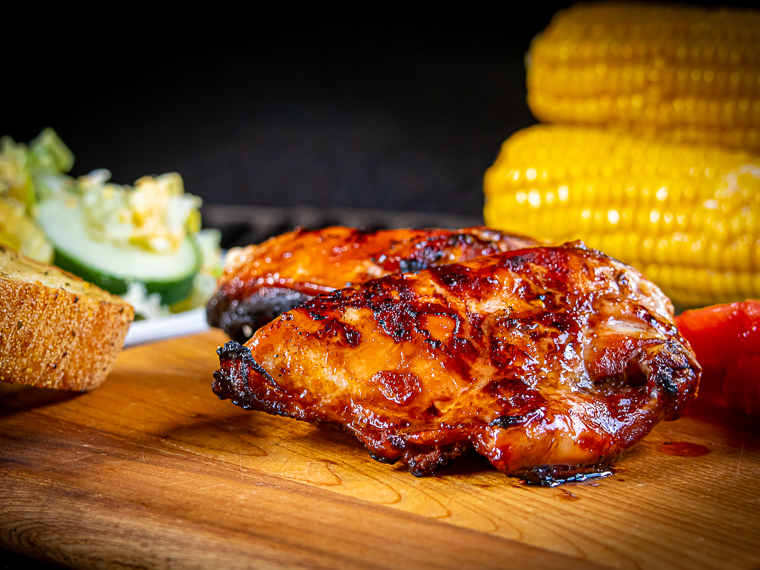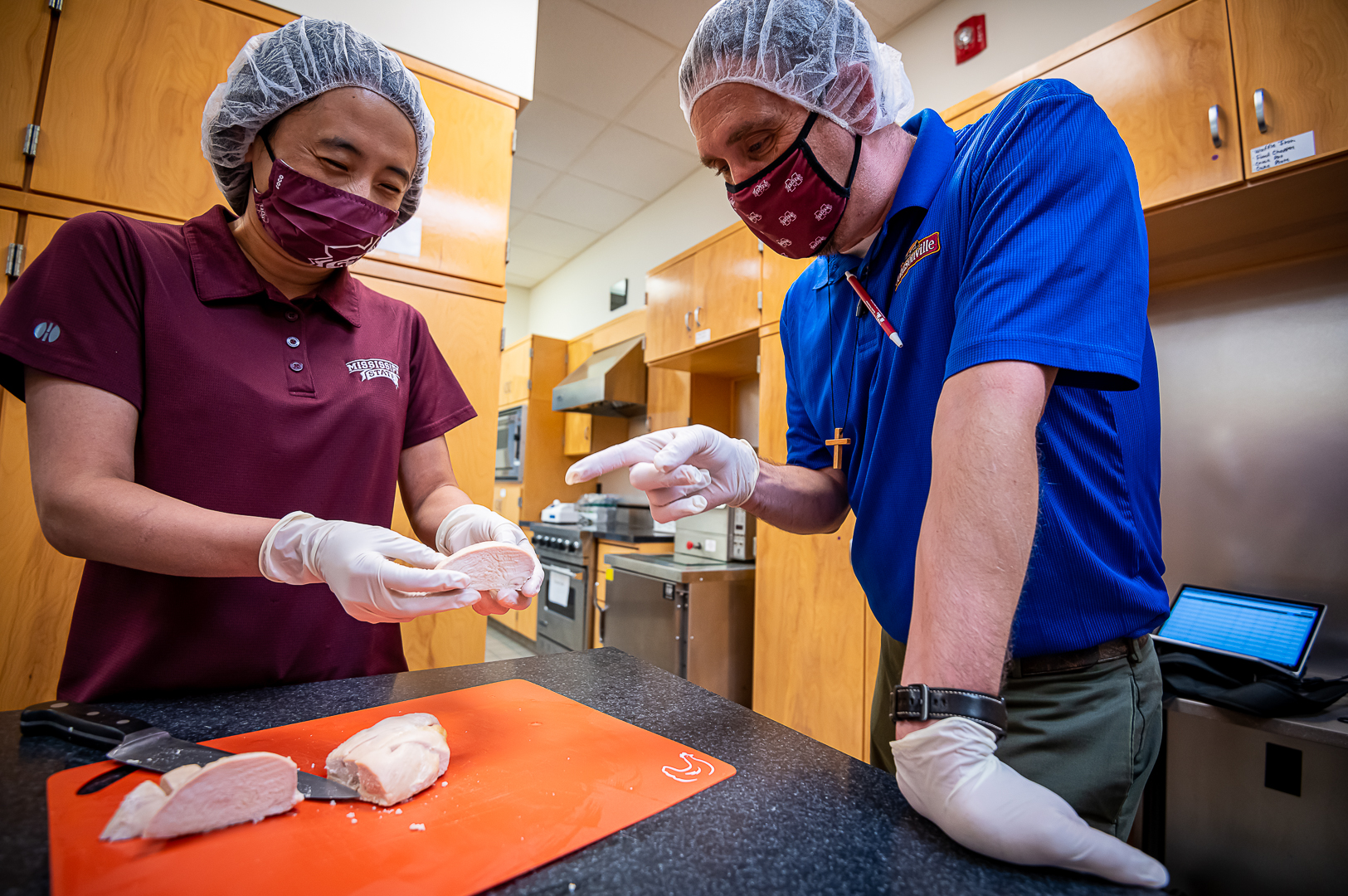The information presented on this page may be dated. It may refer to situations which have changed or people who are no longer affiliated with the university. It is archived as part of Mississippi State University's history.
IN AUGUST 2019, the chicken sandwich wars commenced when Popeyes Louisiana Kitchen challenged chicken sandwich inventor Chick-fil-A with its own version of a crispy chicken breast fillet topped with pickles and mayo on a brioche bun. Two years later, nearly 20 other fast food chains have thrown their signature chicken sandwich into the ring. While buns, sauces, and sides may vary, MAFES researchers are working to ensure the tender high-quality chicken breast fillet remains the shining star of this ubiquitous staple.
Chicken translates to a 20-billion-dollar industry for Mississippi, which produces around 760 million birds annually and directly employs nearly 30,000 people in the state. Woody breast-the most significant meat quality issue for the poultry industry in the past decade-impacts both industry and consumers alike resulting in an estimated economic loss of at least $200 million nationally each year while also compromising texture and taste.
Woody breast is defined as normal, mild, moderate, or severe with varying degrees of hardness. While a normal breast fillet is flexible, a severe woody breast fillet is hard throughout. Mild woody breast is typically hard in the head region and flexible in the tail while moderate woody breast is hard throughout with some flexibility in the tail. Woody breast that is identified as moderate or severe can be graded out of breast meat with the poor-quality portions trimmed off and discarded.
Dr. Wes Schilling, professor in the Department of Food Science, Nutrition and Health Promotion and scientist in the Mississippi Agricultural and Forestry Experiment Station, or MAFES, is one of the researchers waging war against woody breast. He and his team hope to determine what causes woody breast in order to reduce its incidence, improving both consumer quality and producer profit.
"Woody breast leads to less meat production and greater economic losses for the poultry industry. It also can negatively affect meat quality and consumer acceptance," Schilling said. "Some moderate and severe woody breast inevitably makes its way to the marketplace and consumers who have eaten chicken breast and experienced an unexpected crunchy texture may have tasted woody breast meat. Our goal is to identify possible triggers and figure out best practices to have the least amount of woody breast possible."
The team sought to identify differences found in protein expression, biological pathways, and the microbial composition of the gut between unaffected birds and birds with woody breast. They are investigating possible triggers that initiate these differences in order to better understand what causes woody breast.
Schilling added that it is difficult to quantify just how large an impact woody breast has.
"There isn't an estimation of the total amount of woody breast in the poultry industry since only moderate and severe cases affect the eating quality of breasts," Schilling said.
Schilling said while woody breast typically occurs in larger-breasted birds that weigh more and yield more breast meat upon harvest, the issue doesn't happen in all birds displaying these attributes. That's why the team is also focused on environmental and nutritional factors, in addition to genetics.
Dr. Xue Zhang, post-doctoral associate in the Department of Food Science, Nutrition and Health Promotion, explained.
"Certain conditions like oxidative stress might cause certain genes to be overexpressed or underexpressed. That would trigger pathway changes and reflect on protein profiles and also the characteristics of the meat," she said. "Another trigger might be the bacterial community in the chicken house, or the amount of feed, or certain components in the feed, that trigger woody breast. These are all potential factors and we're trying to figure out as much as we can."
The team uses proteomics, which evaluates certain proteins at a specific point, to better understand the biological differences in birds with normal versus woody breasts.
Zhang extracted the proteins and separated them using gels for each breast sample. After that, she sent the gels to collaborators at the University of Kentucky to excise the protein. The researchers then used mass spectrometry and other equipment to quantify the proteins.
"We found that woody breast has increased protein expression in some proteins that are associated with high energy demand, oxidative stress, muscle damage, and inadequate oxygen supply," Zhang said.
The team is also reviewing transcriptomic data that indicates that genetic expression of proteins differs more between woody breast and normal meat than between diets and genetic strains. That data is analyzed, in part, by collaborators at the University of Illinois.
"In the transcriptome, which shows how the genes are expressed, something's happening because while these genes are almost identical between normal and woody-breasted broilers, the gene expression is different so that's another piece of the puzzle," she said.
The team characterized biochemical pathways in live muscle and harvested meat up to 24 hours after slaughter. The meat quality and protein expression were analyzed for woody and normal breast meat from five genetic strains that are commonly used in the broiler industry.
"Woody breast meat exhibited a different postmortem protein profile, indicating a faster and more oxidative muscle to meat conversion process compared to normal breast meat," Zhang said.
She said the team found a specific genetic strain was more prone to the woody breast condition and the proteome indicated that the woody breast meat from this strain was more associated with cell death, protein synthesis, and oxidative stress. They also found that some genetic strains were more susceptible to woody breast with greater dietary intake of essential amino acids, while diet had minimal impacts on other strains.
They are also studying microbiome data, which indicates differences in the bacterial composition in the digestive tract of unaffected and woody breast affected broilers.
"This suggests that unaffected broilers and broilers affected with woody breast respond differently to the nutritional and environmental stimuli and that woody breast myopathy may also be related to the health of the gut microbiome of broilers," Zhang said.
The team will continue to explore the specific gene expression between woody and normal breast meat and further evaluate the impact of the gut microbiome on the development of woody breast meat to find out how these factors impact the incidence of woody breast.
"Woody breast is a big problem and there's been a lot of research done trying to figure the factors that contribute to it," Zhang said. "This research is a puzzle we're trying to solve and putting all the pieces together helps us better understand what ultimately causes woody breast."
In addition to Zhang and Schilling, Dr. Wei Zhai, associate professor in the poultry science department, is on the project. She secured different genetic strains, grew birds, and processed live bird data and meat yields. Dr. Li Zhang, assistant research professor in poultry science, is working on the microbiome research. Dr. Surendranath Suman, a protein identification and proteomics expert at the University of Kentucky, and Dr. Anna Dilger, a transcriptome and genetic expression expert at the University of Illinois, serve on the project as well. The study, which began in 2017 and will conclude in 2022, has already garnered several peer-reviewed publications in prominent journals including four articles featured in Poultry Science, an article featured in the Journal of Agricultural and Food Chemistry, and one in Meat and Muscle Biology.
This research is funded by USDA-NIFA. Peco Foods, Inc., Sanderson Farms, Inc., Wayne Farms, Tyson Foods, Perdue Foods, and Koch Foods have also provided support for this research. In addition to MSU, the University of Kentucky, the University of Illinois, and the University of Georgia contributed to the work.
Woody breast leads to less meat production and Greater economic losses for the poultry industry and can negatively affect meat quality and consumer acceptance.
Dr. Wes Schilling


